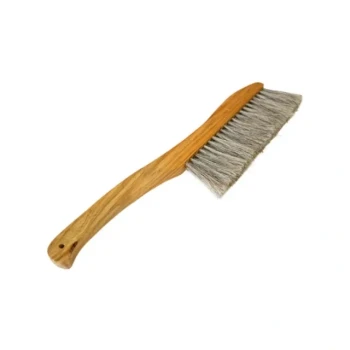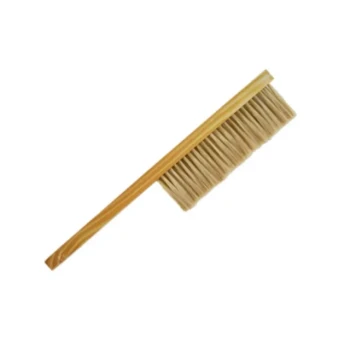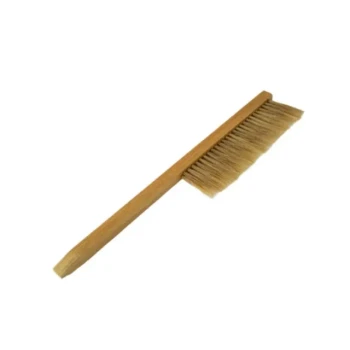A bee brush is a specialized tool used by beekeepers to gently guide honey bees off surfaces without causing them harm. It consists of a handle, typically made of wood, and a long tuft of very soft bristles designed to avoid injuring the bees' delicate wings and bodies. Its primary purpose is to clear bees from frames during hive inspections or honey harvesting, allowing the beekeeper to work safely and efficiently.
The true purpose of a bee brush is not simply to remove bees, but to manage them with minimal stress and disruption. While it is an essential tool for precision, its effectiveness depends entirely on the beekeeper's technique and understanding of bee behavior.
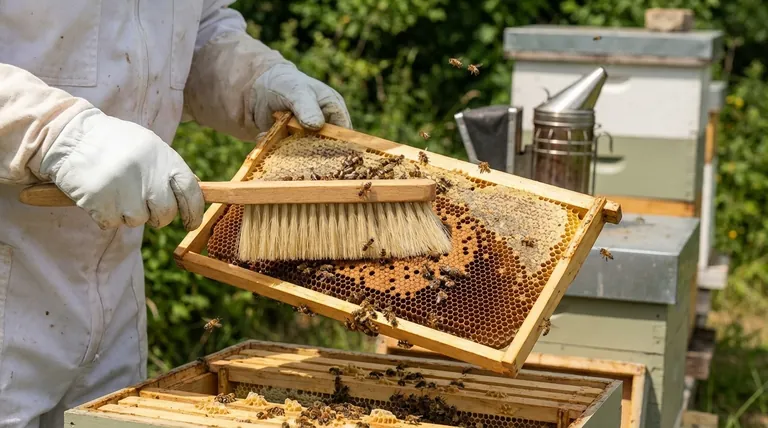
The Core Functions of a Bee Brush
A bee brush is a simple tool, but its application is critical in several key beekeeping scenarios. Its value lies in providing a gentle alternative to more aggressive methods of clearing bees.
Facilitating Detailed Hive Inspections
During a hive inspection, a beekeeper needs a clear view of the comb to check for the queen, assess the brood pattern, and look for signs of disease.
A brush allows the beekeeper to gently sweep away a curtain of bees to examine the cells underneath. This precision is impossible with other methods.
Ensuring a Clean Honey Harvest
When removing frames of honey, they must be free of bees before being brought indoors for extraction.
The brush is used to sweep any remaining bees off the honey-filled frames after an initial shake. This ensures no bees are accidentally carried away from the hive.
Protecting the Bees and the Beekeeper
The soft bristles are specifically designed to be non-injurious. Harming bees during an inspection can release alarm pheromones, agitating the entire colony and making the process more difficult and dangerous.
Using a brush calmly and deliberately helps maintain a peaceful hive environment.
Mastering the Brushing Technique
How you use the brush is as important as what it is. An improper technique can be counterproductive, causing more agitation than it prevents.
Use a Gentle, One-Directional Sweep
The correct motion is a slow and gentle sweep across the frame. Avoid rapid, jerky movements or patting the bees, as they can perceive this as an attack.
Always brush in one direction, ideally downward toward the hive entrance or onto the top of the frames below.
Observe the Colony's Reaction
Pay close attention to the sound and behavior of the hive. If the bees start to get louder, more defensive, or begin to "boil" over the frames, it is a sign of agitation.
At this point, it is best to pause, use a puff of smoke to calm the colony, and give them a moment before proceeding.
Understanding the Trade-offs and Alternatives
While essential, the bee brush is not the only tool for moving bees, and it is not always the best choice for every situation. Understanding its limitations is key to effective beekeeping.
The Potential for Agitation
Even a gentle brush can be irritating to bees. Over-brushing or brushing a particularly defensive colony can quickly escalate the situation, leading to more stings and a stressed hive.
Alternatives: The Frame Shake
For clearing a large number of bees from a frame quickly, a sharp, downward shake is often more efficient. This dislodges the majority of bees, who then fall back into the hive body.
A brush is then used to remove the few stubborn bees that remain.
Alternatives: The Bee Escape
For honey harvesting, a "bee escape" is the gentlest method. This is a one-way door placed between the honey boxes and the brood chamber. Over 24 hours, the bees move down into the main hive but cannot return, leaving the honey boxes nearly bee-free with minimal disturbance.
Making the Right Choice for Your Goal
The best method for moving bees depends entirely on your immediate objective and the temperament of your specific hive.
- If your primary focus is a detailed brood inspection: The bee brush is your best tool for carefully clearing small patches of bees to examine individual cells.
- If your primary focus is harvesting a few honey frames: A combination of a sharp shake followed by the bee brush to remove stragglers is the most efficient method.
- If your primary focus is minimizing all hive disturbance: For harvesting, using a bee escape board the day before is the gentlest, albeit slowest, approach.
Ultimately, mastering the bee brush is a crucial step in learning to work with your bees calmly and respectfully.
Summary Table:
| Feature | Description |
|---|---|
| Primary Use | Gently guide bees off frames during inspections and harvesting. |
| Key Benefit | Minimizes bee stress and injury, preventing hive agitation. |
| Best For | Detailed hive inspections and clearing stragglers after a frame shake. |
| Technique | Use slow, one-directional sweeps; observe hive behavior to avoid agitation. |
Ready to manage your hives with precision and care?
As a trusted supplier for commercial apiaries and beekeeping equipment distributors, HONESTBEE provides the high-quality, gentle tools you need for efficient and respectful hive management. Our bee brushes are designed for durability and bee safety, supporting your commitment to a healthy colony.
Contact HONESTBEE today to discuss your wholesale supply needs and discover our full range of beekeeping essentials.
Visual Guide
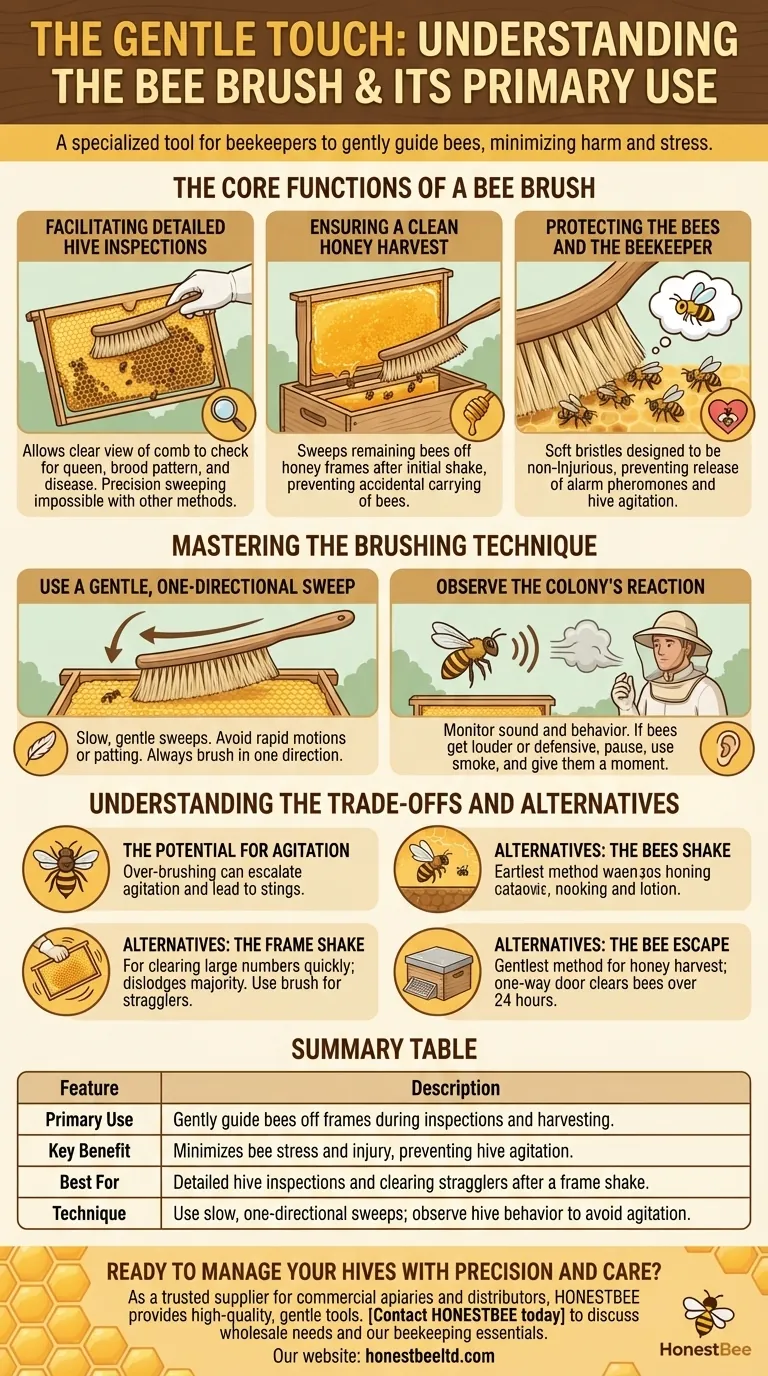
Related Products
- Wooden Bee Brush with Triple Row Artificial Fiber for Beekeeping
- Wooden Bee Brush with Double-Row Horsehair Bristles
- Premium Triple-Row Horsehair Bee Brush
- Double Row Artificial Fiber Bee Brush for Beekeeping
- Classic Wooden Bee Brush with Double-Row Boar Bristles
People Also Ask
- What is the purpose of a bee brush? Master Gentle Hive Management for Healthier Bees
- Why do beekeepers use a bee brush? The Essential Tool for Gentle Bee Handling
- What are the characteristics of the bristles on a bee brush? Designed for Gentle Persuasion, Not Force
- What is a bee brush and how is it used in beekeeping? A Guide to Gentle Bee Handling
- What are some optional tools that can be useful in beekeeping? Boost Efficiency & Hive Health


